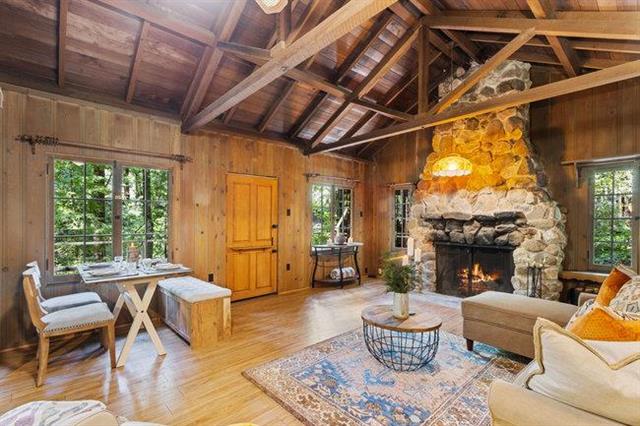SLV Homes: Market News and CZU Update
By M.C. Dwyer
Defensible Space Inspections Under Assembly Bill 38, most property sellers in “High or Very High Fire Hazard Severity Zones” must document that their property is in compliance with this new law. To find out if you are in one of those zones, you or your real estate agent can order a Natural Hazard Report. There are also required disclosures about the home’s fire prevention features. At no cost, sellers can ask their local fire department or Cal Fire for an inspection, followed by another visit if necessary to Certify the property after all work is completed. Buyers may agree to handle the compliance for the sellers, as long as the property is in compliance within 1 year. For details, visit: slvpost.com/slv-homes-defensible-space-and-home-hardening
Housing Affordability Declines After a decade of rising home prices, up 18% across California this year sadly, only 25% of California households can afford to buy an average home. Now, the Bay Area has two of the most expensive housing regions in the U.S.: San Francisco and San Jose, up there with New York, Los Angeles, San Diego. Home prices here cost nearly 10x the average income, and many buyers are using their stock portfolios to source their down payments.
A study by Clever Real Estate showed that, since 1965 and after accounting for inflation, income and wages have only gone up about 15%. But home prices, adjusted for inflation, rose about 120%. The home price to income ratio used to be around 2x. Home ownership in California used to be much easier, and there was less imbalance between the “haves” and the “have nots.” Some are moving out of state because the national average home price to income ratio is around 5x.
Home ownership is one of the best ways to increase personal wealth and reduce your housing costs during retirement. A fixed rate loan secures your monthly mortgage payment, versus rents that keep going up: nationally, rent rose 16% this year. There are programs for moderate income home buyers in cities including Scotts Valley and Santa Cruz. This year I helped a home buyer use a low down payment loan available for rural areas. Affordability most recently peaked in 2012, when 56% of buyers could afford a home, around the bottom of the last real estate cycle. Someone who can’t qualify now could set a goal to be prepared to buy on the next dip in the real estate cycle.
Building More Affordable Housing California has a housing deficit of about 3.5 million homes. Senate Bill 9 goes into effect 1/1/22 – allowing parcels zoned for single-family homes in urban areas to be divided into two lots: to build an additional home and possibly an Accessory Dwelling Units on each lot, as long as each lot is at least 1200 square feet, and property owners occupy one of the housing units after splitting or adding units. It’s already become controversial in some cities that are vowing to apply the most conservative interpretation of the law. Santa Cruz County happens to have one of the highest ratios of eligibility in the state: studies show the county may have 43,000 eligible lots with 8,000 new units feasible. Considering we are the only California County that does not import water from other sources, and our County is slow to permit new housing, this may get interesting.
Zillow – In another sign the housing market is slowing a bit, and illustrating the lack of reliability of their home value “Zestimates,” Zillow, a publicly-traded real estate company, just announced they are closing their I-Buyer division and expect to take losses of about $550 million on thousands of homes for which they paid too much.
CZU Wildfire Survivors Dave Reid at Santa Cruz County Office of Response, Resilience and Recovery says he has nearly completed a thorough study of the impact of the Declaration of Geologic Hazards, the recorded document to replace the previously proposed Covenant. Even though Declarations are already recorded on about 700 Santa Cruz County properties, Dave took the next steps to consult with the Department of Insurance, and United Policy Holders, who ran the Declaration by Federal National Mortgage Association, none of whom anticipate any negative repercussions. Although survivors in geologically hazardous zones feel concerned about having this document recorded on their title, when it isn’t recorded on neighbors’ homes that survived the fires, actually, when those neighbors decide to sell, a Natural Hazard Report by a 3rd party will be given to buyers, illustrating the same geologic risks.
Our CZU rebuild We hope PG&E will connect my husband’s power pole next week. Next step is to hire someone to take down several large dead and hazardous Douglas Fir trees. That’s not covered by insurance, nor are the repairs needed after Anvil’s heavy equipment damaged the steepest part of the driveway. Meanwhile, he is working with his contractor to replace the plastic water tank that melted (the metal tank for fire-fighting survived). The design/engineering team is working on his project again. Once they’ve finished, he can apply for his permit to rebuild.
“M.C.” (MaryCatherine) Dwyer, MBA, REALTOR®
CA DRE License 01468388
EXP Realty of California, Inc.
Sources: Reuters, Clever Real Estate, Case Schiller, CNBC, Mercury News, Santa Cruz Sentinel, California Association of REALTOR®s, National Association of REALTOR®s.
Photo courtesy of Tracy Peer
The statements and opinions contained in this article are solely those of the individual author and do not necessarily reflect the positions or opinions of eXp Realty, LLC, or its subsidiaries or affiliates (the “Company”). The Company does not assume any responsibility for, nor does it warrant the accuracy, completeness, or quality of the information provided.




